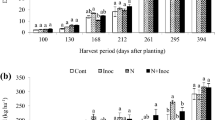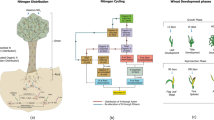Abstract
The seasonal patterns of growth and symbiotic N2 fixation under field conditions were studied by growth analysis and use of15N-labelled fertilizer in a determinate pea cultivar (Pisum sativum L.) grown for harvest at the dry seed stage.
The patterns of fertilizer N-uptake were almost identical in pea and barley (the non-fixing reference crop), but more fertilizer-N was recovered in barley than in pea. The estimated rate of N2 fixation in pea gradually increased during the pre-flowering and flowering growth stages and reached a maximum of 10 kg N fixed per ha per day nine to ten weeks after seedling emergence. This was the time of early pod-development (flat pod growth stage) and also the time for maximum crop growth rate and maximum green leaf area index. A steep drop in N2 fixation rate occurred during the following week. This drop was simultaneous with lodging of the crop, pod-filling (round pod growth stage) and the initiation of mobilization of nitrogen from vegetative organs. The application of fertilizer-N inhibited the rate of N2 fixation only during that period of growth, when the main part of fertilizer-N was taken up and shortly after. Total accumulation of fixed nitrogen was estimated to be 244, 238 and 213 kg N ha−1 in pea supplied with nil, 25 or 50 kg NO −3 −N ha−1, respectively. About one-fourth of total N2 fixation was carried out during preflowering, one fourth during the two weeks of flowering and the remainder during post-flowering. About 55% of the amount of N present in pods at maturity was estimated to be derived from mobilization of N from vegetative organs. “Starter” N (25 or 50 kg NO −3 −N ha−1) did not significantly influence either dry matter and nitrogen accumulation or the development of leaf area. Neither root length and root biomass determined 8 weeks after seedling emergence nor the yield of seed dry matter and nitrogen at maturity were influenced by fertilizer application.
Similar content being viewed by others
References
Andersen A J, Haahr V, Jensen E S and Sandfær J 1983 Effect of N-fertilizer on yield, protein content, and symbiotic N fixation inPisum sativum L. grown in pure stand and mixtures with barley.In Perspectives for Peas and Lupins as Protein Crops. Eds. R Thompson and R Casey. pp 205–218. Nijhoff, Dordrecht, The Netherlands.
Bethlenfalvay G J and Phillips D A 1977 Ontogenetic interactions between photosynthesis and symbiotic N2 fixation in legumes. Plant Physiol. 60, 419–421.
Bethlenfalvay G J, Abu-Shakra S S, Fishbeck K and Phillips D A 1978 The effect of source-sink manipulations on nitrogen fixation in pea. Physiol. Plant. 43, 31–34.
Bremner J M and Mulvaney C S 1982 Nitrogen—Total.In Methods of Soil Analysis, Part 2. Ed. A L Page. pp. 595–641. Am. Soc. Agron., Madison, Wis., USA.
Dean J R and Clark K W 1980 Effect of low level nitrogen fertilization on nodulation, acetylene reduction and dry matter in faba beans and three other legumes. Can. J. Plant Sci. 60, 121–130.
Fiedler R and Proksch G 1975 The determination of nitrogen-15 by emission and mass spectrometry in biochemical analysis: A review. Anal. Chim. Acta 78, 1–62.
Flinn A M 1974 Regulation of leaflet photosynthesis by developing fruit in the pea. Physiol. Plant. 31, 275–278.
Fried M and Broeshart H 1975 An independent measurement of the amount of nitrogen fixed by a legume crop. Plant and Soil 43, 707–711.
Jensen E S 1986a Symbiotic N2 fixation in pea and field bean estimated by15N fertilizer dilution in field experiments with barley as a reference crop. Plant and Soil 92, 3–13.
Jensen E S 1986b The influence of rate and time of nitrate supply on nitrogen fixation and yield in pea (Pisum sativum L.). Fert. Res. 10, 193–202.
Jensen E S, Andersen A J and Thomsen J D 1985 The influence of seed-borne N in15N isotope dilution studies with legumes. Acta Agric. Scand. 35, 438–443.
LaRue T A G and Kurz W G W 1973 Estimation of nitrogenase in intact legumes. Can. J. Microbiol. 19, 304–305.
Lawrie A C and Wheeler C T 1973 The supply of photosynthetic assimilates to nodules ofPisum sativum L. in relation to the fixation of nitrogen. New Phytol. 72, 1341–1348.
Mahon J D and Child J J 1979 Growth response of inoculated peas (Pisum sativum) to combined nitrogen. Can. J. Bot. 57, 1687–1693.
Milbourn G M and Harwick R C 1968 The growth of vining peas. I. The effect of time of sowing. J. Agric. Sci., Camb. 70, 393–402.
Minchin F R, Witty J F, Sheehy J E and Muller M 1983 A major error in the acetylene reduction assay: decrease in nodular activity under assay conditions. J. Exp. bot. 34, 641–649.
Newman E I 1966 A method of estimating the total root length in a sample. J. Appl. Ecol. 3, 139–145.
Oghoghorie C G O and Pate J S 1971 The nitrate stress syndrome of the nodulated field pea (Pisum arvense L.). Techniques for measurement and evaluation in physiological terms.In Biological Nitrogen Fixation in Natural and Agricultural Habitats. Eds. T A Lie and E G Mulder. pp 185–202. Plant and Soil spec Vol. Martinus Nijhoff, Dordrecht, The Netherlands.
Pate J S 1958 Nodulation studies in legumes. I. The synchronization of host and symbiotic development in the field pea,Pisum arvense L. Aust. J. Biol. Sci. 11, 516–527.
Pate J S 1985 Physiology of pea—A comparison with other legumes in terms of economy of carbon and nitrogen in whole-plant and organ functioning.In The Pea Crop. Eds. P D Hebblethwaite, M C Heath and T C K Dawkins. pp 279–295. Butterworths, London.
Salter P J and Drew D H 1965 Root growth as a factor in the response ofPisum sativum L. to irrigation. Nature 206, 1063–1064.
Spaeth S C and Sinclair T R 1985 Linear increase in soybean harvest index during seed-filling. Agron. J. 77, 207–211.
Sprent J I and Minchin F R 1983 Environmental effects on the physiology of nodulation and nitrogen fixation.In Temperate Legumes: Physiology, Genetics and Nodulation Eds. D G Jones and D R Davies. pp 269–317. Pitman, London.
Vetter H and Scharafat S 1964 Die Wurzelverbreitung landwirtschaftlicher Kulturpflanzen im Unterboden. Z. Acker. Pflanzenbau 120, 275–297.
Witty J F 1983 Estimating N2-fixation in the field using15N-labelled fertilizer: Some problems and solutions. Soil Biol. Biochem. 15, 631–639.
Young J P W 1982 The time course of nitrogen fixation, apical growth and fruit development in peas. Ann. Bot. 49, 135–139.
Author information
Authors and Affiliations
Rights and permissions
About this article
Cite this article
Jensen, E.S. Seasonal patterns of growth and nitrogen fixation in field-grown pea. Plant Soil 101, 29–37 (1987). https://doi.org/10.1007/BF02371027
Received:
Accepted:
Issue Date:
DOI: https://doi.org/10.1007/BF02371027




